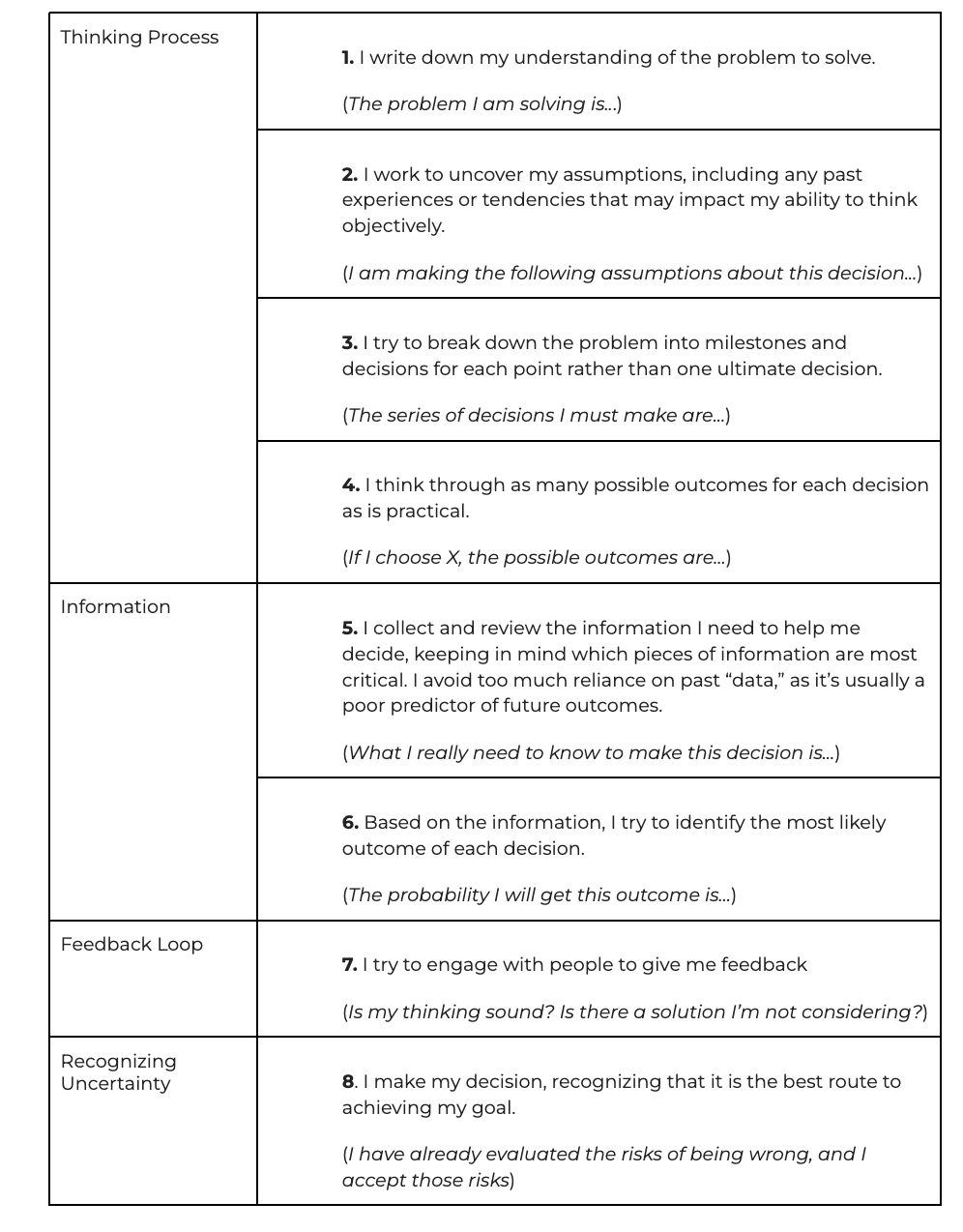When you’re making a decision, your objective is to choose the option that gains you the most ground in achieving your goals, taking into account how much you’re willing to risk. — Annie Duke, How to Decide: Simple Tools for Making Better Choices
Whether my clients are weighing career options, solving a professional challenge, or making a personal decision, the most common questions I hear are, “How do I know if I’m doing it right?” and “How can I avoid making a mistake?”
I remind them that decision-making is a process, not a one-time event. We often unconsciously expect that our decisions (and their consequences) are final and irrevocable. This mindset actually throws off our ability to make sound decisions.
The antidote to this is an effective decision-making framework, one that helps you arrive at decisions with clarity and confidence. Such a framework allows you to look at even high-stakes decisions objectively and break them down into a series of logical steps.
Viewed objectively, it’s easier to accept that decisions do not result in mistakes, only outcomes.
So, what does an effective decision-making framework look like?
Based on my research and experience, any good framework should include four critical factors:
- Thinking Process – This is how you approach making the decision. You want a process that will give you confidence in your choice while avoiding bias.
- Information – These are the inputs you use to aid your decision-making process.
- Feedback Loop – These are the checks and balances you have in place to ensure well-rounded thinking.
- Recognizing Uncertainty – This is coming to terms with the fact that nothing is certain, but you have done your best to gain the most ground in the right direction.
With that lens, here’s how I break down the steps in my own decision-making framework. You can use the same steps to tackle any personal or professional problem that you need to solve:

Being at peace with decisions is one of the hardest things for leaders to come to terms with. However, it’s much easier when you know your decision was made with clarity and the best critical thinking tools at your disposal.
I encourage you to apply these steps to your next big decision. If you find yourself struggling, the outside validation and confirmation of a professional coach is a great option to pursue.
Book a free consultation with me if you could use help to develop your decision-making process or generally navigate the many challenges that come with being in a leadership role.
For more insight into avoiding common decision-making roadblocks, I encourage you to consult any or all of these additional resources.
Additional Resources
Make Better Decisions by Challenging Your Expectations by Cheryl Strauss Einhorn (Article)
This resource goes into detail on how unchecked bias, assumptions, and personal judgment can cloud your decision-making. It will help you examine your own assumptions and look at decision-making as a thinking process.
How to Make Rational Decisions in The Face of Uncertainty by Cheryl Strauss Einhorn (Article)
This resource will help you fine-tune your thinking process with steps to ensure you focus on the right information and formulate questions that get you to the answers you actually need.
Four Great Questions to Help with Your Decision-Making by Suzy McAlpine (Article)
This resource contains four questions to ask yourself when faced with a particularly big decision. Adding these to your framework will help boost confidence in the fact that you’ve chosen a good path forward.
How to Decide: Simple Tools for Making Better Choices by Annie Duke (Book)
This book will take you through examining your past decisions to how to set up a decision-making process (tools) that will lead to your most favorable range of outcomes.



0 Comments